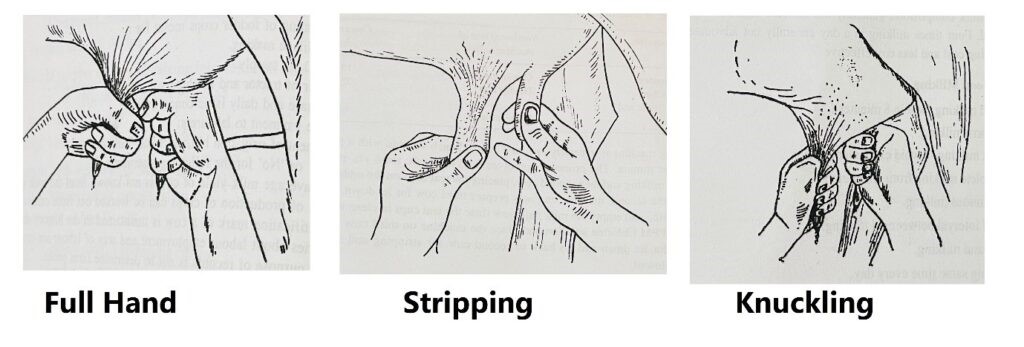Methods of milking
A) Hand milking
- Full hand milking known as fisting:
- Full hand milking simulates natural sucking of a calf.
- Cows with large teats and buffaloes are milked full hand method.
- It is done by grasping the teats with whole hand and steadily pressing it equally on all sides against the palm with the fingers.
- Full hand milking removes milk quicker than stripping because of no loss of time in changing the position of the hand.
- Stripping:
- Generally stripping method is adopted in small cow with smaller teats.
- Stripping is accomplished by firmly seizing the teats at its base between front of the thumb and forefinger.
- Drawing them down the entire length of the teat while pressing simultaneously to cause the milk to flow in a steam.
Advantages
- The last drown milk at the close of milking called stripping is richer in fat than fore milk.
Disadvantages
- Application of unequal pressure more than necessary on teats.
- More frictional effect on teats by sliding the finger and thumb up and down.
- Production of undue irritation of skin resulting in sores.
- Necessity of undesirable lubrication of the teats frequently with milk, oil, water or grease.
- More pain to animal in stripping operation in event of chapped, cracked, sore or teat affected with cowpox.
- Loss of richest part of milk due to inefficient milking.
3.Knuckling.
- In this method, teats are holding diagonally.
- Teat is grasped between folded thumb and fore figure.
- Animal feels discomfort, pain and uneasiness during the milking time due to unequal pressure exerted on the top surface layer of the teat.
- It is bad method of milking.

B) Machine milking:
- Approximately 55 % of total labor time in dairy herd operation involved in milking machine milking reduced it to an appreciable degree.
- Nearly 160 cows are milked per hour with machine milking per hour with 10 to 12 cows are milked per with hand milking.
